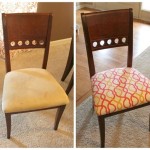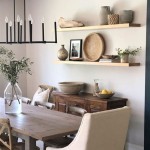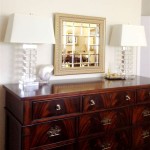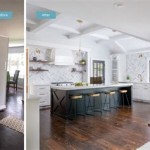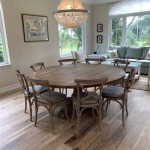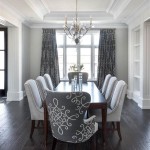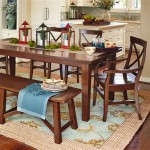Wine Barrel Dining Room Table: A Distinctive Piece of Furniture
A wine barrel dining room table introduces a unique blend of rustic charm and functional design into any home. Repurposing discarded wine barrels transforms a symbol of celebration and tradition into a centerpiece for gatherings and shared meals. The construction and incorporation of these tables require a thoughtful understanding of the materials, design options, and the inherent character of aged wood.
Unlike mass-produced furniture, each wine barrel table possesses an individuality borne from its previous life. The stains, markings, and natural imperfections in the wood tell a story of winemaking and aging. This inherent character contributes to the table's visual appeal and distinguishes it from generic dining furniture.
Understanding Wine Barrel Construction and Materials
Wine barrels are typically crafted from oak, chosen for its durability, impermeability, and subtle contribution to the flavor profile of the wine. The specific type of oak used, its origin, and the toasting process all influence the wood's characteristics. These characteristics manifest in the finished table as variations in color, grain pattern, and the presence of subtle aromatic compounds.
A standard wine barrel is composed of several key components: staves, hoops, a head, and occasionally, an internal structure. Staves are the individual curved pieces of wood that form the barrel's body. Metal hoops, traditionally made of steel or iron, hold the staves tightly together, providing structural integrity. The head refers to the circular wooden piece that seals the ends of the barrel. An internal structure, if present, might include a support post or additional bracing to reinforce the table's base.
The process of selecting and preparing a wine barrel for transformation into a table is crucial. Barrels are often sourced from wineries or cooperages after they have completed their intended lifespan in wine production. The barrels undergo a thorough cleaning to remove residual wine and tartrates. Depending on the desired aesthetic, the exterior of the barrel may be lightly sanded to reveal the wood's natural grain or left with its weathered patina. The integrity of the hoops is carefully inspected, and loose or damaged hoops are repaired or replaced to ensure stability.
The interior of the barrel is also carefully considered. Some table designs retain the original curvature of the staves, creating a distinctive concave surface. Others involve flattening the staves and reassembling them to create a traditional tabletop. The choice depends on the desired aesthetic and the table's intended use.
Design Variations and Construction Techniques
Wine barrel tables exhibit a wide range of design variations, catering to different aesthetic preferences and functional requirements. These variations encompass the table's shape, size, base design, and the incorporation of additional materials.
Round tables are a popular choice, often utilizing the entire barrel as the base. These tables provide a conversational layout and are well-suited for smaller dining spaces. Rectangular tables, on the other hand, typically require the disassembly and reassembly of the staves to create a flat, elongated surface. These tables accommodate larger gatherings and offer a more traditional dining experience.
The base of the table can be constructed in several ways. The simplest approach involves using the entire barrel as a pedestal, providing a visually striking and stable support. Alternatively, the staves can be disassembled and reconfigured to create a more open and airy base. Metal legs or a combination of wood and metal are also employed to achieve a contemporary or industrial aesthetic.
The tabletop itself can be crafted from various materials. Solid wood tabletops, made from reclaimed lumber or newly milled planks, complement the rustic character of the barrel base. Glass tabletops provide a sleek and modern contrast, allowing the barrel's structure to remain visible. Stone tabletops, such as granite or marble, introduce an element of sophistication and durability.
Construction techniques vary depending on the design and the materials used. Reinforcing the barrel structure is essential to ensure stability and prevent warping or cracking. This may involve adding internal supports, applying epoxy resin to stabilize the wood, or securing the hoops with additional fasteners. Joinery techniques, such as mortise and tenon or dovetail joints, are employed to connect the staves and create a durable bond. The surface of the tabletop is typically sanded smooth and finished with a protective coating, such as polyurethane or varnish, to enhance its durability and resist staining.
Incorporating a Wine Barrel Table into a Dining Room
Integrating a wine barrel dining room table into a home requires careful consideration of the surrounding décor and the overall aesthetic. The table's rustic charm can be enhanced by pairing it with complementary furniture and accessories.
Choosing the right chairs is crucial. Wooden chairs with upholstered seats provide a comfortable and visually appealing contrast to the barrel's rough texture. Metal chairs with a vintage finish can complement an industrial-style dining room. Benches offer a more casual seating option and can be easily tucked away when not in use.
Lighting plays a significant role in setting the mood and highlighting the table's unique features. A chandelier with Edison bulbs can evoke a vintage ambiance. Pendant lights suspended above the table provide focused illumination. Wall sconces can add ambient light and create a warm and inviting atmosphere.
Accenting the table with appropriate accessories can further enhance its visual appeal. A runner made from natural fibers, such as burlap or linen, can add texture and warmth. Centerpieces featuring candles, flowers, or vintage wine bottles can create a focal point. Placemats and napkins in neutral tones can complement the table's natural colors.
The surrounding walls should also be carefully considered. Exposed brick walls or textured paint can enhance the table's rustic charm. Neutral colors, such as beige or gray, provide a versatile backdrop that allows the table to stand out. Artwork featuring landscapes or wine-related themes can further reinforce the overall aesthetic.
The placement of the table within the dining room is also important. A central location allows the table to become the focal point of the room. Positioning the table near a window can maximize natural light and enhance its visual appeal. Ensuring ample space around the table allows for comfortable movement and prevents the room from feeling cramped.
Maintaining a wine barrel dining room table involves regular cleaning and occasional refinishing. Dusting the table regularly with a soft cloth helps to prevent the buildup of grime. Spills should be wiped up immediately to prevent staining. Applying a furniture polish or wax periodically can help to protect the finish and maintain its luster. Depending on the level of use and the environmental conditions, the table may require refinishing every few years to restore its original appearance.

Wine Barrel Table
Loire Double Wine Barrel Gathering Table With Glass And Wood Top

Rustic Barrel Table Amish Direct Furniture

Standard Whiskey Barrel Pub Table Counter Height Solid Wood Top Garden Home Bar Man Cave American Oak Etsy

60 Rustic Country Wine Barrel Wedding Ideas Hi Miss Puff Page 7 Furniture Table

Napa East Wine Barrel Table Set Cabinet Base Winecellarhq Com

Wine Barrel Table Country Dining Room Santa Barbara By Arvizu Contracting Houzz Ie

21 Modern Tables Enhancing Interior Design With Unique Furniture Artworks Wine Barrel Table

Amish Rustic 5 Pc Whiskey Barrel Pub Dining Set Table Bar Stools Wine Game Room Ebay

Napa East Wine Barrel Table Set Cabinet Base Modish Store


